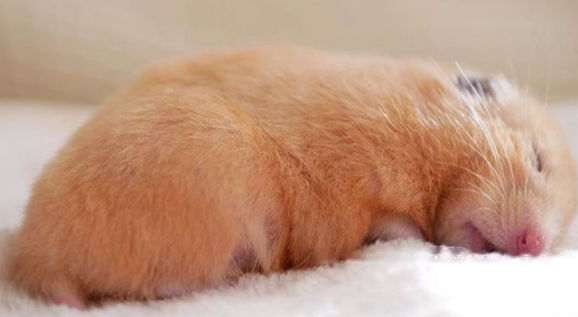Some animals go into a lethargic state and dormant in order to survive the harsh winter when food is scarce. During hibernation, animal body temperature decreases, metabolism slows down, and energy consumption is greatly reduced. There are many animals that hibernate, such as bears, marmots, frogs, snakes and so on.

had to sleep
hamsters also have a certain ability to hibernate, in a sense It is said that they are more resistant to cold, but their hibernation ability is much inferior to those of the hibernation professional households mentioned above. Animals accustomed to hibernation will organize and premeditately save a lot of energy in advance for the winter, while the hibernation of hamsters is more of a desperate gamble, so this kind of unprepared hibernation is especially dangerous. Take your life. Some people call this unprofessional hibernation of hamsters pseudo-hibernation.
Why sleep
The decrease in ambient temperature is the main reason for hamsters to enter hibernation. But not all hamsters are the same. In hypothermia, some hamsters will hibernate, some will not, and some will hibernate and eventually die of hypothermia. This hibernation ability is most likely determined by genetic factors.
Another important factor that affects hibernation is light. Under the same temperature conditions, if the light intensity is weak and the time is short, hamsters are more likely to enter the hibernation state.
Even if the environment is warm, the lack of food and water will make hamsters go into hibernation to save their energy, but domestic pet hamsters rarely have this problem. In addition, isolation and stress also slightly altered the hibernation behavior of hamsters, though not as much as temperature and light.
In conclusion, the harsher the environment, the easier it is for hamsters to hibernate.
No rats going to sleep tonight
Hibernating hamsters can be dangerous. Because of their small size, they lose body temperature faster than larger animals and are prone to death from hypothermia. Hamsters have limited energy reserves, and if they hibernate for too long, they will die from exhaustion. In addition, although the kidneys of hamsters can adapt to a dry environment, hamsters during hibernation still have to get up and drink water frequently, otherwise they will dehydrate and die.
Therefore, when the weather turns cooler, pay more attention to the temperature and the condition of the hamster. Hamsters love to sleep. If you suspect that they are in hibernation, you can grab a pinch of bedding and sprinkle it on the sleeping hamster. If the bedding on the hamster disappears after a period of time, it means that the hamster has been active, and the owner can rest assured. . On the contrary, you have to find ways to raise the temperature of the cage to keep the hamster alive.
The hamster doesn't really sleep to death, it just reduces mobility. At this time, it is necessary to quickly provide warm measures and a large amount of high-calorie food. Otherwise, because the sleeping hamster will not wake up to feed, it will eventually starve to death.
How exactly?
Hibernation First Aid
Although the owners will take care Hamsters don't let them hibernate, but there are occasional mistakes that leave hamsters lying dead in their cages with cold hands and feet. Don't be in a hurry to wipe your tears, hamsters hibernate to resist the harsh environment, so they are not so easy to sacrifice in the hibernation state. As long as they are found in time and rescued, they can still be rescued. The heart of first aid is raising the hamster's temperature. The hamster can be placed on a hot water bottle wrapped in a towel, or warmed by gently holding the hamster in your hand. When the body temperature rises, the hamster will slowly wake up. At this time, use a dropper or a syringe to feed them some warm water (it is better to add some sugar), and be careful not to get the hamster wet. Once the hamster is fully awake, it is time to feed it some digestible paste. Hamsters that are getting better can recover on their own as long as they are returned to the cage and placed in a warm place, and given enough food and water.
![[Dog Training 5] The training method of pet dog dining etiquette](/static/img/12192/12192_1.jpg)




